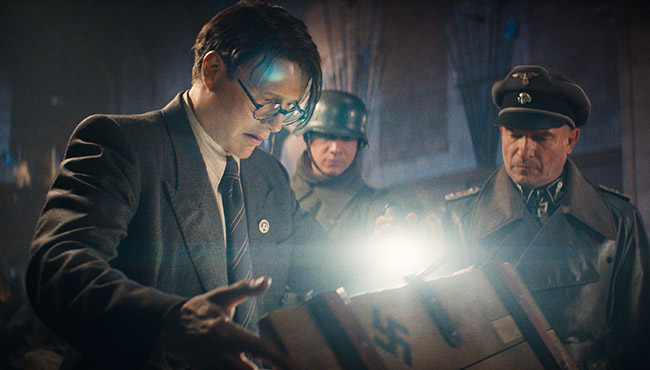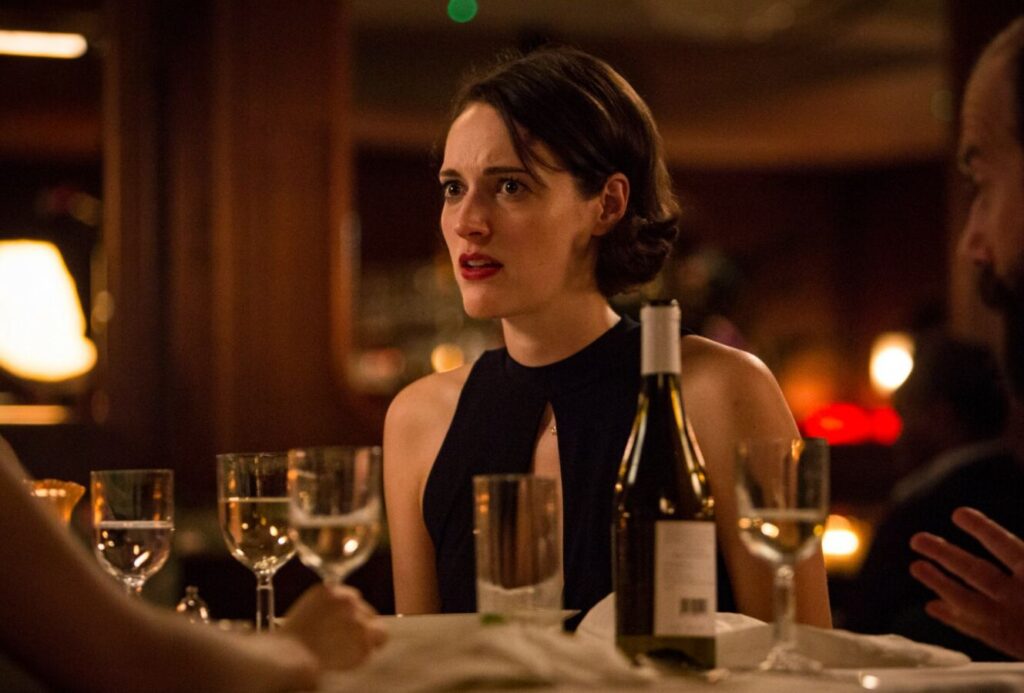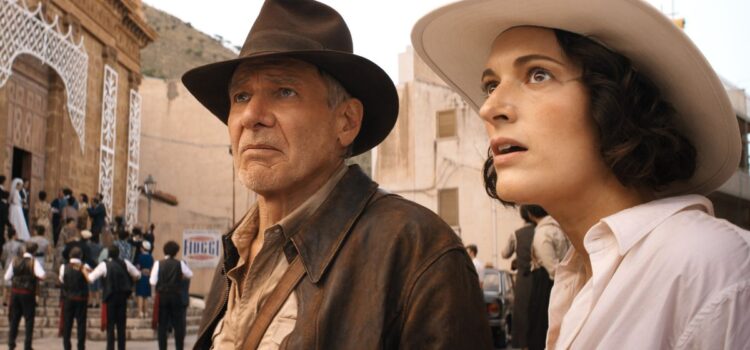By Lynn Venhaus
The man, the myths, and the legend are back, and there’s both a rueful twinge and wave of nostalgia at the sight of the brown fedora and 80-year-old Harrison Ford trying so hard to be swashbuckling in “Indiana Jones and the Dial of Destiny.”
Ford, whose laconic delivery and devil-may-care charm secured his place in cinematic history long ago, has played his share of men of action, giving us two cultural icons in Han Solo of the “Star Wars” franchise and archeological adventurer Dr. Henry Jones in the Raiders/Indiana Jones series.
In this fifth installment, the famous archeologist races against time to retrieve a legendary artifact that can change the course of history.
As Indy, Ford puts the whip in whip-smart, and it’s a treat to see him return to heroic form. And how sentimental is seeing a reunion with Karen Allen as Marion, his one true love?
However, she’s but a blip in this new universe. What is generally regarded as the final installment in the venerable 42-year-old series is an overstuffed globe-trotting adventure involving Archimedes, the Antikythera, Apollo 11, the U.S.- Soviet Union space race, World War II, Nazis, and the Vietnam War. And changing times and technology. And time travel. Whew.
It’s both overwhelming and underwhelming – a whole lot of whelm, or lack thereof, in 2 hours, 34 minutes, as they continent-hop in planes, trains, and automobiles — and there’s even a horse to ride in New York City.
The production’s artisans are masters at establishing an atmosphere, from academia’s dusty bookshelves to scary ancient caves where peril’s an instant away. Oscar-winning production designer Adam Stockhausen, for “The Grand Budapest Hotel” in 2015, and cinematographer Phedon Papamichael, Oscar nominee for “The Trial of the Chicago 7” and “Nebraska,” smoothly move between years, wars, conflicts and high-speed chases.

Indy’s now being pulled in a direction he thought he was done with, but he finds himself battling against not-dormant foes – very present Nazis, tying Third Reich masterminds to 1960s NASA scientists.
And by default, linking his life’s work studying the Siege of Syracuse in Sicily (213-212 B.C.) with the evil he’s facing at present, and coming face to face with Archimedes. Yes, Archimedes – the Greek mathematician, physicist, engineer, astronomer, and inventor. His dial becomes a hot potato, an artifact that propels this chapter. You may want to brush up beforehand on antiquity.
As Indy, Ford retreats into a loner role, hiding from the world, grieving the loss of his son and marriage, retiring as a professor, and trying to adapt to a different time..
Nevertheless, his past as a heroic Allied Forces intelligence officer, comes rip-roaring back into focus when Voller shows up, a character partly inspired by German engineer Wernher von Braun. Mads Mikkelsen, always a formidable screen presence, excels as a power-hungry villain (the best kind), ready to lead a new world order when authoritarians are in charge.
You may recall the original film featured Nazis as the villains, set in 1936. So, cut to 33 years later and Indy is a little ambivalent about his enemy helping in the space mission.
The sprawling cast represents a bridge to the past, with John Rhys-Davies returning as Sallah, Toby Jones as fellow archeologist Basil Shaw, and Antonio Banderas briefly as Indy’s old friend, sailor and diver Renaldo. Phoebe Waller-Bridge brings a modern edge as Basil’s sassy, smart daughter Helena, Indy’s goddaughter.
Noteworthy supporting roles include Boyd Holbrook as Voller’s nihilistic trigger-happy henchman Klabor, and young Ethann Isidore as Helena’s handy street-smart helper.
James Mangold knows how to direct crowd-pleasing fare – he’s helmed “Ford v. Ferrari,” “Logan,” “Walk the Line” and “3:10 to Yuma,” to name a few. He starts off strong, capturing thrilling derring-do in wartime espionage action as a flashback, with a de-aged Harrison Ford for 24 minutes, followed by a zippy chaotic chase scene through crowded Manhattan streets during the ticker-tape parade honoring the Apollo 11 astronauts, all the while establishing Indy’s resourcefulness then and now.
However, the movie gets bogged down by its exposition. The dense screenplay, written by Jez Butterworth, John-Henry Butterworth, and David Koeppe (Crystal Skull), all veterans behind major movies, focuses on the precious dial mechanism, but must throw in obstacles that stretch the story beyond believability.
To keep us invested, we need to sort out why it’s sought after, what happens in the wrong hands, and what are the consequences either way. If you just want to see Indy save one world, never mind what happened in the past or is ahead in the future, settle in for a bumpy ride.

Hence, herein lies the problem. While interesting in spurts, “Dial of Destiny” is a bridge too far — noble in thought but too tangled in execution.
Steven Spielberg and George Lucas are executive producers, but this is the first one Spielberg hasn’t directed. Lucas was the catalyst for the first story, conceived in the early 1970s and meant to be a homage to action-packed early 20th century serials. Philip Kaufman helped develop it, Spielberg came aboard, and ‘80s hotshot Lawrence Kasdan, who wrote “The Empire Strikes Back,” was brought in to write the script.
In the prequel ‘Temple of Doom,’ set in 1935, Indy is hired to find a gem and rescue a village’s children from a cult leader.
In ‘Last Crusade,’ a sequel to Raiders (set in ’36, this is ’38), Indy is searching for his kidnapped father, played by Sean Connery, and hoping to find the Holy Grail before the Nazis do.
Set in 1957, ‘Crystal Skull’ was meant to be a tribute to sci-fi B-movies of that era, with Soviet villains also searching in Peru for a telepathic crystal skull, and Indy reuniting with Marion, who introduces their son, Mutt Williams (Shia LeBeouf).
If ranking the series, the instant classic “Raiders of the Lost Ark” (1981) would be at the top, followed by “Indiana Jones and the Last Crusade” (1989). “Indiana Jones and the Temple of Doom” (1984) and “Indiana Jones and the Kingdom of the Crystal Skull” (2008) are my least favorite, putting this one in the middle.
That’s what we have to factor in to how we enjoy this fifth film – our response to the previous four. When you hear that magnificent theme written by John Williams, who has scored each Indy adventure since the original, you are swept away again.
We can base this new adventure on our appreciation for the rip-roaring escapism, Ford as one of our national treasures, and the visionary minds that brought this classic throwback into our lives.
“Indiana Jones and the Dial of Destiny” can’t stand on its own merit without the others, but will have to suffice as a pleasant waltz down memory lane. And Ford reminds us of his famous line in ‘81: “It’s not the years, it’s the mileage.”

“”Indiana Jones and the Dial of Destiny” is a 2023 action-adventure directed by James Mangold and starring Harrison Ford, Phoebe Waller-Bridge, Mads Mikkelsen, Karen Allen, Antonio Banderas and Boyd Holbrook. It is Rated PG-13 for sequences of violence and action, language and smoking and runs 2 hours, 34 minutes. It opens in theaters June 30. Lynn’s Grade: B-.

Lynn (Zipfel) Venhaus has had a continuous byline in St. Louis metro region publications since 1978. She writes features and news for Belleville News-Democrat and contributes to St. Louis magazine and other publications.
She is a Rotten Tomatoes-approved film critic, currently reviews films for Webster-Kirkwood Times and KTRS Radio, covers entertainment for PopLifeSTL.com and co-hosts podcast PopLifeSTL.com…Presents.
She is a member of Critics Choice Association, where she serves on the women’s and marketing committees; Alliance of Women Film Journalists; and on the board of the St. Louis Film Critics Association. She is a founding and board member of the St. Louis Theater Circle.
She is retired from teaching journalism/media as an adjunct college instructor.

